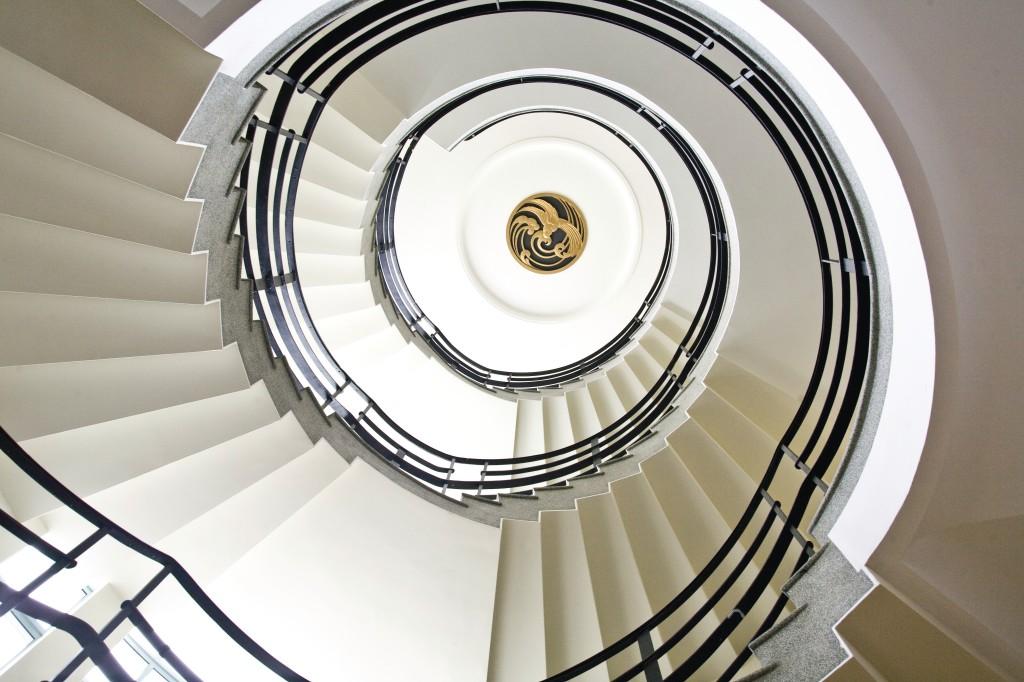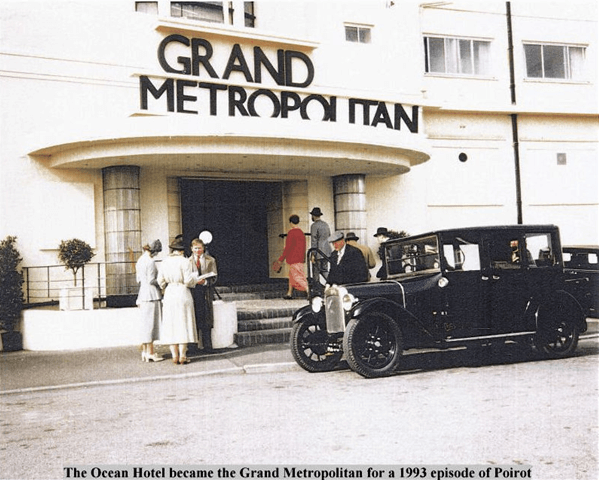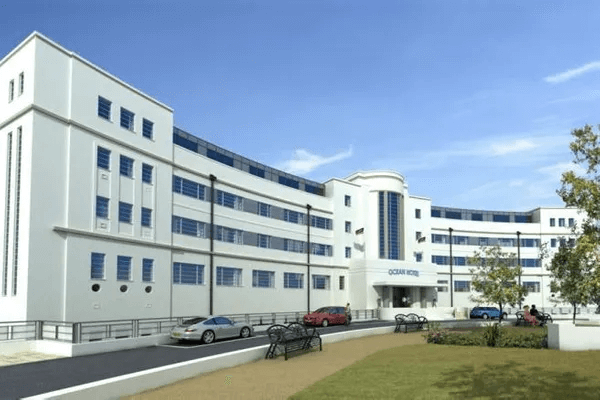The Grand Ocean was designed by architect Richard, RWH Jones (who has also designed the nearby now Grade ll listed Lido) in the Streamline Moderne style which was perfect for extravagant coastal properties. When it first opened its double golden doors in July 1938, the hotel was the height of glitz and sophistication and epitomised Thirties seaside Art Deco architecture. It featured every amenity that the guests of the day could possibly desire. In its Art Deco heyday, Bette Davis swished down the spiral staircase and dancers filled the ballroom. The Ocean Hotel was host to royalty, film stars and nobility, including famous ballerina Margo Fonteyn. It was the place to stay and the place to be seen. It was what today we would probably call an inclusive resort. There were entertainments and sports available for guests – it wasn’t necessary for them to leave the premises to enjoy fine dining, dancing and music. Being in the south of England, with its balmy weather, the hotel also boasted a much-frequented outdoor swimming pool for leisure and for aquatic sports. There was, and still is thanks to careful restoration, the most amazing spiralling staircase.
The History of our Home
The 426 bedrooms boasted central heating and hot and cold water. A publicity brochure from the time told of the hotel’s restaurant with lofty ceilings, its roof gardens and ballroom with resident dance orchestra – the sprung floor was said to accommodate ‘a company of 300 dancers in comfort’. A week’s inclusive stay in a single room cost three and a half guineas. The opening ceremony included a dinner attended by about 400 guests, including the Queen’s brother, the Earl of Glamis. The rich and famous came to lounge around the hotel’s fine outdoor pool or sip cocktails at its fashionable American-style bar. This first, glamorous phase was to be short lived.

Of course, though, as soon as the war came along, England had to tighten its belt. The rich and famous clients no longer came. Those who could afford to have left the country. Those who couldn’t have weightier things on their mind, Staff members were recruited into the forces or into essential occupations. There was no room in England for a luxury hotel. The hotel and the pavilions across the rear of the site were commandeered by the Auxiliary Fire Service and opened as a training college in October 1941. It was considered vital to the war effort.
And like so many gorgeous places, it didn’t come out of the war extremely well. It wasn’t bombed or damaged by the enemy but hordes of firefighters had more important things to worry about than the decor of this beautiful building.
So a few years after the war, in 1953, along came Billy Butlin and became a Butlin’s Holiday camp. Billy Butlin had made a considerable amount of money by creating several ‘holiday camps’ in the UK. The price was £250,000 and Butlin apparently called it “the best investment I ever made”. Workers spent six months restoring the near derelict building. An advert from the Sixties promoting the new Butlin’s described it as a “Continental-style seaside resort hotel with glass-enclosed sun-decks – a sunbather’s paradise!”. It also promoted “television theatres” and “constant hot water”
The Grand Ocean became known as the ”Honeymoon Hotel” as people escaped the austerity of the wartime to experience a bit of luxury and glamour at the Grand Ocean. Although the holiday camp existed before he came along, many people think he was the inventor of these kitsch places. I say kitsch because they provided cheap accommodation along with entertainment such as knobbly knee contests, beauty pageants, glamourous granny extravaganzas, talent contests and plentiful beer, Babycham and, most probably, fishcakes and sausages.
Billy Butlin was expanding his holiday empire into hotels and he couldn’t resist the Ocean, calling it the best investment he’d ever made. After a few months of renovation, the Ocean was once again teeming with guests. Not the rich and famous now though. It was a step up from the holiday camps, certainly but only just.
The Ocean Hotel always had a great buzz about it, with hundreds of guests, known as campers by the staff, coming and going each week. The Redcoats were always a good laugh, brilliantly entertaining the happy campers, with lots of audience participation. Des O`Connor, Jimmy Tarbuck and other well known stars all worked at the Ocean as Redcoats in that era. Jimmy Noon is another name worthy of a mention. Jim was the resident organist at the Ocean Hotel for the best part of forty years.

It remained with Butlin’s until 1972 when the company was taken over by Rank Organisation. There was one last glimpse of its past In1993 when the hotel became a TV star when it was used in an episode of Poirot. It was the perfect backdrop to this story of Agatha Christie’s detective Hercule Poirot who, while on vacation in Brighton, solved the mystery of stolen jewels.
In 1998 it was bought by the Grand Leisure Hotel Group and acquired the “Grand” in its name. Story has it that more than a few confused guests arriving at Brighton Station, would hail a taxi telling the cabbie that they were staying at The Grand Hotel. However, they would very soon be in for a shock when a rather snooty concierge informed them, there was only one ‘Grand Hotel’ in Brighton, and their accommodation was some five miles out of town at what used to be a Butlin’s holiday hotel.
Time and lack of investment began to take its toll and the Hotel took on a more salacious reputation with Mr &Mrs Smith as the most popular name in the hotel register and with single guests checking in looking for love. As its reputation and fortunes turned, there was talk that it could be used to house asylum seekers. Finally in December 2004 it closed its doors as a hotel forever.
The Ocean Hotel’s sad demise. The Ocean Hotel belonged to another age and as such, could never have survived in the 21st century, the seaside holiday of yesteryear gone. Its last appearance came in 2005 a theatrical production, Dirty Wonderland, was staged in the former hotel.
The site was sold to be redeveloped into luxury apartments by developer, Explore Living which is part of the Laing O’Rourke construction firm behind the Terminal 5 development at Heathrow and the new hospital building at Royal Sussex in Brighton.
When it bought the Grade II listed building in 2005, it looked less than grand. “The windows were smashed, and vandals and vermin had got in. We aim to preserve the original character.” Most of the 4-acre sloping site was cleared and the swimming pool was demolished. The Old Hotel Building was restored retaining many original features, entrance with its fountain, the reception desk, stunning staircase, lift, golden doors and beautiful garden with fountains and ponds reflecting the bow of the Queen Mary Liner.
Nowadays the original building looks resplendent, albeit strangely silent even a little ghostly. Sadly it is no longer the beating heart of Saltdean. Billy Butlin and his famous Redcoats are long gone, along with all the happy campers, who for over fifty years were so much part of the Saltdean scene. A metal sculpture of dancers beside the doctor’s surgery is a reminder of its wilder heady heyday.

The Grand Ocean Estate is a more tranquil residential estate, with the Grand II listed Grand Ocean Hotel building and 5 other modern buildings Atlantic Heights, Pacific Heights, Caspain Heights, Ionian Heights and Baltic View, that house our 235 apartments. There were 185 and 50 shared leasehold properties and the 2 doctors surgery created across the estate between 2005 and 2014. A separate building Timor House was built on an adjacent plot and is affordable housing for Brighton and Hove City Council Tenants. Nestled on its commanding position with its magnificent views across to the South Downs, sweeping through the valley, past the restored Saltdean Lido to the white cliffs, the beach and undercliff walk.
On a quiet evening the echoes of jazz, laughter from the long-gone magnificent ballroom and whispers of lovers seeking privacy, can be discerned echoing across the years in the rustle of the breeze in the gardens of the Grand Ocean Estate. As the sun sets across the rooftops across the valley and you catch the sound of a breaking distant wave reminding us of the timeless romantic history of our home.